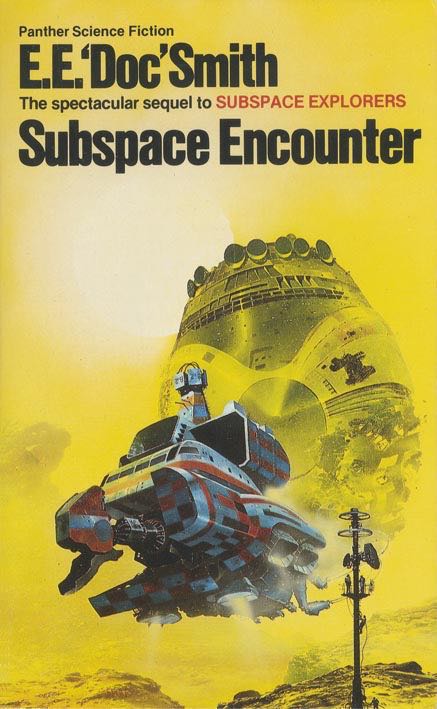Subspace Encounter
Series: Subspace 2
Reviewed date: 2006 May 30
Rating: 3
198 pages
Although it does not compare in scope to his Lensman or Skylark sagas, E. E. "Doc" Smith's two-volume Subspace story is excellent in its own right.
The central idea of the novels is the science of psionics, or mental powers. The development of bona fide mental powers such as telepathy, telekinesis, and teleportation open up exciting new possibilities for humanity. In Subspace Explorers, the Galactic Federation makes it biggest discovery yet: a parallel "Second Space" universe. Using psionics, a spaceship can be "rotated" through subspace and emerge into Second Space. In Second Space, mankind encounters the Justiciate, a civilization of men much like its own--but ruled by a despot diametrically opposed to all things psionic.
The Justiciate is undergoing political and social upheaval. Although the government prohibits psionics, an underground organization of psiontists is working to secure their civil rights. Spear-headed by Sonrodnar Rodnar and Daughtmarja Marrjyl of Orm, the psiontist cabal infiltrates the office of the Supreme Grand Justice himself. But far from being able to incite revolution, the psiontists discover that--for their own protections--they must secretly support the autocratic ruler against an even greater enemy: the Garshans, who appear to be preparing their own revolution. When all seems lost and the Justiciate must surely fall to the Garshans, the psiontists make contact with the Galactic Federation spaceship that has just rotated through subspace. It's a race against time: can the psiontists of the Justiciate convince the Galaxians to help them defeat the Garshans?
Subspace Encounter shares many elements with the Doc's more well-known books. There is the telepathic element reminiscent of the Lensman books, and there is the cadre of super-scientists that could be straight out of the Skylark universe.
Subspace Encounter could be great if it had stronger characters. The book is so chock full of action that the characters are barely introduced, to say nothing of being fully developed. The human characters feel like cheap knockoffs of Seaton and Crane, and the Second Space characters remind one of nothing so much as heros from an Edgar Rice Burroughs adventure. Fun reading for fans of Doc Smith, but otherwise not great. (On the other hand, this is probably the Doc's most well-written book, if one analyzes from a technical standpoint. His dialogue isn't atrocious, and he has developed an intriguing culture that isn't merely a glorified version of Boy Scouts.)
